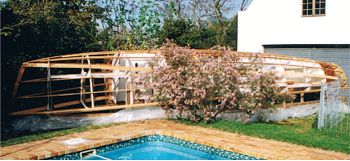|
Page 2 - Hull stringers & Backbone
|

|
All stringers have been fitted and glued into their slots in the bulkhead edges. The backbone has been installed, screwed and glued to blockings on the bulkheads.
|
|

|
Charles Papish's boat again. The aft frame is temporary, so it can be made from scraps. It is used only to define the shape of the hull to form the scoop stern.
At this stage doublers have been fitted to the smaller tangent stringers. These run along the line where the flat and radiused plywood panels meet. The sheer clamps have also been fitted along the deck edge. They are the start of the hull/deck joint detail.
|
|

|
The stingers that intersect the stem are sunk in flush with the sides of the stem. Those that intersect the sides of the backbone are screwed and glued against the side of the backbone.
The bow stringers in this photo are different from what is on the drawings. I modified the drawings when building "Black Cat" after finding that the curve was difficult to define when skinning the radius with only one stringer. The drawings show two radius stringers throughout, whereas this photo shows that "Black Cat" has one forward of the 4th bulkhead and two aft of it.
|
|

|
Same stage viewed from the side.
|
|

|
Close-up view of a tangent doubler. The tangent stringers are 12mm shallower than the other stringers but are fitted into slots of the same size. The 12mm difference is filled with a plywood doubler, with the outer face flush with the bulkhead edges. The transition from sheet to radius plywood is made on this plywood doubler.
|
|
|